The Vinum volume manager
The Vinum volume manager
Last updated: 30 January 2000
ABSTRACT
The Vinum Volume Manager is a block device driver which implements virtual
disk drives. It isolates disk hardware from the block device interface and maps
data in ways which result in an increase in flexibility, performance and
reliability compared to the traditional slice view of disk storage.
Vinum implements the RAID-0, RAID-1 and RAID-5 models, both individually
and in combination.
Contents
Introduction
The problems
Current implementations
How Vinum addresses the Three Problems
The big picture
Some examples
Increased resilience: RAID-5
Object naming
Startup
Performance issues
The implementation
Driver structure
Availability
Future directions
References
Introduction
Disk hardware is evolving rapidly, and the current UNIX disk abstraction is
inadequate for a number of modern applications. In particular, file systems
must be stored on a single disk partition, and there is no kernel support for
redundant data storage. In addition, the direct relationship between disk
volumes and their location on disk make it generally impossible to enlarge a
disk volume once it has been created. Performance can often be limited by the
maximum data rate which can be achieved with the disk hardware.
The largest modern disks store only about 50 GB, but large installations, in
particular web sites, routinely have more than a terabyte of disk storage, and
it is not uncommon to see disk storage of several hundred gigabytes even on PCs.
Storage-intensive applications such as Internet World-Wide Web and FTP servers
have accelerated the demand for high-volume, reliable storage systems which
deliver high performance in a heavily concurrent environment.
The problems
Various solutions to these problems have been proposed and implemented:
Disks are too small
The ufs file system can theoretically span more than a petabyte
(2**50 or 1,125,899,906,842,624 bytes) of storage, but no current disk
drive comes close to this size. Although this problem is not as acute as it was
ten years ago, there is a simple solution: the disk driver can create an
abstract device which stores its data on a number of disks. A number of such
implementations exist, though none appear to have become mainstream.
Access bottlenecks
Modern systems frequently need to access data in a highly concurrent manner.
For example, wcarchive.cdrom.com maintains up to 3,600 concurrent
FTP sessions and has a 100 Mbit/s connection to the outside world,
corresponding to about 12 MB/s.
Current disk drives can transfer data sequentially at up to 30 MB/s, but this
value is of little importance in an environment where many independent processes
access a drive, where they may achieve only a fraction of these values. In such
cases it's more interesting to view the problem from the viewpoint of the disk
subsystem: the important parameter is the load that a transfer places on the
subsystem, in other words the time for which a transfer occupies the drives
involved in the transfer.
In any disk transfer, the drive must first position the heads, wait for the
first sector to pass under the read head, and then perform the transfer. These
actions can be considered to be atomic: it doesn't make any sense to interrupt
them.
Consider a typical transfer of about 10 kB: the current generation of
high-performance disks can position the heads in an average of 6 ms. The
fastest drives spin at 10,000 rpm, so the average rotational latency (half a
revolution) is 3 ms. At 30 MB/s, the transfer itself takes about 350 µs, almost
nothing compared to the positioning time. In such a case, the effective
transfer rate drops to a little over 1 MB/s and is clearly highly dependent on
the transfer size.
The traditional and obvious solution to this bottleneck is ``more spindles'':
rather than using one large disk, it uses several smaller disks with the same
aggregate storage space. Each disk is capable of positioning and transferring
independently, so the effective throughput increases by a factor close to the
number of disks used.
The exact throughput improvement is, of course, smaller than the number of disks
involved: although each drive is capable of transferring in parallel, there is
no way to ensure that the requests are evenly distributed across the drives.
Inevitably the load on one drive will be higher than on another.
The evenness of the load on the disks is strongly dependent on the way the data
is shared across the drives. In the following discussion, it's convenient to
think of the disk storage as a large number of data sectors which are
addressable by number, rather like the pages in a book. The most obvious method
is to divide the virtual disk into groups of consecutive sectors the size of the
individual physical disks and store them in this manner, rather like taking a
large book and tearing it into smaller sections. This method is called
concatenation and has the advantage that the disks do not need to have
any specific size relationships. It works well when the access to the virtual
disk is spread evenly about its address space. When access is concentrated on a
smaller area, the improvement is less marked. The following figure illustrates
the sequence in which storage units are allocated in a concatenated
organization.
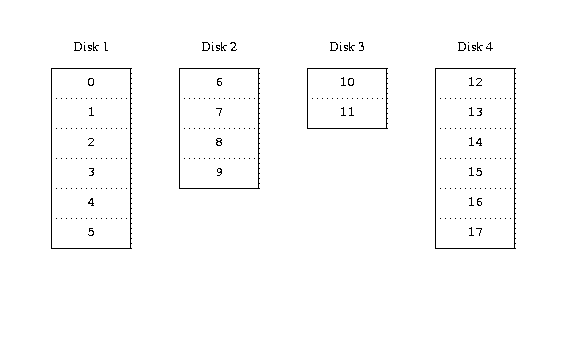
Concatenated organization
An alternative mapping is to divide the address space into smaller, even-sized
components and store them sequentially on different devices. For example, the
first 256 sectors may be stored on the first disk, the next 256 sectors on the
next disk and so on. After filling the last disk, the process repeats until the
disks are full. This mapping is called striping or RAID-0, though the
latter term is somewhat misleading: it provides no redundancy. Striping
requires somewhat more effort to locate the data, and it can cause additional
I/O load where a transfer is spread over multiple disks, but it can also provide
a more constant load across the disks. The following figure illustrates the
sequence in which storage units are allocated in a striped organization.

Striped organization
Data integrity
The final problem with current disks is that they are unreliable. Although disk
drive reliability has increased tremendously over the last few years, they are
still the most likely core component of a server to fail. When they do, the
results can be catastrophic: replacing a failed disk drive and restoring data to
it can take days.
The traditional way to approach this problem has been mirroring, keeping
two copies of the data on different physical hardware. Since the advent of the
RAID levels, this technique has also been called RAID level 1 or
RAID-1. Any write to the volume writes to both locations; a read can be
satisfied from either, so if one drive fails, the data is still available on the
other drive.
Mirroring has two problems:
-
The price. It requires twice as much disk storage as a non-redundant solution.
-
The performance impact. Writes must be performed to both drives, so they take
up twice the bandwidth of a non-mirrored volume. Reads do not suffer from a
performance penalty: it even looks as if they are faster. This issue will be
discussed below.
An alternative solution is parity, implemented in the RAID levels 2, 3, 4
and 5. Of these, RAID-5 is the most interesting. As implemented in Vinum, it
is a variant on a striped organization which dedicates one block of each stripe
to parity of the other blocks: As implemented by Vinum, a RAID-5 plex is
similar to a striped plex, except that it implements RAID-5 by including a
parity block in each stripe. As required by RAID-5, the location of this parity
block changes from one stripe to the next. The numbers in the data blocks
indicate the relative block numbers.
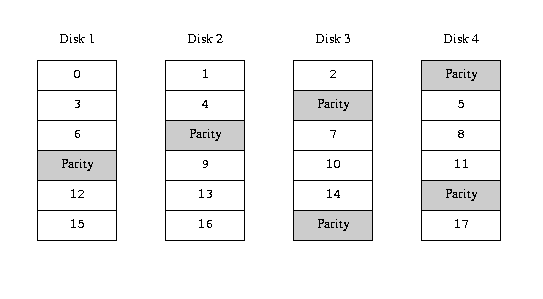
RAID-5 organization
Compared to mirroring, RAID-5 has the advantage of requiring significantly less
storage space. Read access is similar to that of striped organizations, but
write access is significantly slower, approximately 25% of the read performance.
If one drive fails, the array can continue to operate in degraded mode: a read
from one of the remaining accessible drives continues normally, but a read from
the failed drive is recalculated from the corresponding block from all the
remaining drives.
Current implementations
The three requirements discussed above have solutions that are only partially
compatible. In particular, redundant data storage and performance improvements
require different solutions and affect each other negatively.
The current trend is to realize such systems in disk array hardware, which
looks to the host system like a very large disk. Disk arrays have a number of
advantages:
-
They are portable. Since they have a standard interface, usually SCSI, but
increasingly also IDE, they can be installed on almost any system without kernel
modifications.
-
They have the potential to offer impressive performance: they offload the
calculations (in particular, the parity calculations for RAID-5) to the array,
and in the case of replicated data, the aggregate transfer rate to the array is
less than it would be to local disks. RAID-0 (striping) and RAID-5
organizations also spread the load more evenly over the physical disks, thus
improving performance. Nevertheless, an array is typically connected via a
single SCSI connection, which can be a bottleneck, and some implementations show
surprisingly poor performance. Installing a disk array does not guarantee
better performance.
-
They are reliable. A good disk array offers a large number of features designed
to enhance reliability, including enhanced cooling, hot-plugging (the ability to
replace a drive while the array is running) and automatic failure recovery.
On the other hand, disk arrays are relatively expensive and not particularly
flexible. An alternative is a software-based volume manager which
performs similar functions in software. A number of these systems exist,
notably the The
VERITAS® volume manager, Solaris DiskSuite,
IBM's Logical
Volume Facility and SCO's Virtual Disk
Manager. An implementation
of RAID software and a separate volume
manager are also available for Linux.
Vinum
Vinum is an open source volume
manager implemented under FreeBSD. It was
inspired by the The
VERITAS® volume manager volume manager and maintains many of the
concepts of VERITAS®. Its key features are:
-
Vinum implements RAID-0 (striping), RAID-1 (mirroring) and RAID-5 (rotated
block-interleaved parity). In RAID-5, a group of disks are protected against
the failure of any one disk by an additional disk with block checksums of the
other disks.
-
Drive layouts can be combined to increase robustness, including striped mirrors
(so-called ``RAID-10'').
-
Vinum implements only those features which appear useful. Some commercial
volume managers appear to have been implemented with the goal of maximizing the
size of the spec sheet. Vinum does not implement ``ballast'' features such as
RAID-4. It would have been trivial to do so, but the only effect would have
been to further confuse an already confusing topic.
-
Volume managers initially emphasized reliability and performance rather than
ease of use. The results are frequently down time due to misconfiguration, with
consequent reluctance on the part of operational personnel to attempt to use the
more unusual features of the product. Vinum attempts to provide an
easier-to-use non-GUI interface.
How Vinum addresses the Three Problems
As mentioned above, Vinum addresses three main deficiencies of traditional disk
hardware. This section examines them in more detail.
Drive size considerations
Vinum provides the user with virtual disks, which it calls volumes, a term
borrowed from VERITAS. These disks have essentially the same properties as a
UNIX disk drive, though there are some minor differences. Volumes have no size
limitations.
Redundant data storage
Vinum provides both mirroring and RAID-5. It implements mirroring by providing
objects called plexes, each of which is a representation of the data in a
volume. A volume may contain between one and eight plexes.
From an implementation viewpoint, it is not practical to represent a RAID-5
organization as a collection of plexes. This issue is discussed below.
Performance issues
Vinum implements both concatenation and striping. Since it exists within the
UNIX disk storage framework, it would be possible to use UNIX partitions as the
building block for multi-disk plexes, but in fact this turns out to be too
inflexible: UNIX disks can have only a limited number of partitions. Instead,
Vinum subdivides a single UNIX partition into contiguous areas called
subdisks, which it uses as building blocks for plexes.
The big picture
As a result of these considerations, Vinum provides a total of four kinds of
abstract storage structures:
-
At the lowest level is the UNIX disk partition, which Vinum calls a drive.
With the exception of a small area at the beginning of the drive, which is used
for storing configuration and state information, the entire drive is available
for data storage.
-
Next come subdisks, which are part of a drive. They are used to build
plexes.
-
A plex is a copy of the data of a volume. It is built out of subdisks,
which may be organized in one of three manners:
-
A concatenated plex uses the address space of each subdisk in turn.
-
A striped plex stripes the data across each subdisk. The subdisks must
all have the same size, and there must be at least two subdisks to distinguish
it from a concatenated plex.
-
Like a striped plex, a RAID-5 plex stripes the data across each subdisk.
The subdisks must all have the same size, and there must be at least three
subdisks, since otherwise mirroring would be more efficient.
Although a plex represents the complete data of a volume, it is possible for
parts of the representation to be physically missing, either by design (by not
defining a subdisk for parts of the plex) or by accident (as a result of the
failure of a drive).
-
A volume is a collection of between one and eight plexes. Each plex
represents the data in the volume, so more than one plex provides mirroring. As
long as at least one plex can provide the data for the complete address range of
the volume, the volume is fully functional.
RAID-5
Conceptually, RAID-5 is used for redundancy, but in fact the implementation is a
kind of striping. This poses problems for the implementation of Vinum: should
it be a kind of plex or a kind of volume? In the end, the implementation issues
won, and RAID-5 is a plex type. This means that there are two different ways of
ensuring data redundancy: either have more than one plex in a volume, or have a
single RAID-5 plex. These methods can be combined.
Which plex organization?
Vinum implements only that subset of RAID organizations which make sense in the
framework of the implementation. It would have been possible to implement all
RAID levels, but there was no reason to do so. Each of the chosen organizations
has unique advantages:
-
Concatenated plexes are the most flexible: they can contain any number of
subdisks, and the subdisks may be of different length. The plex may be extended
by adding additional subdisks. They require less CPU time than striped or
RAID-5 plexes, though the difference in CPU overhead from striped plexes is not
measurable. On the other hand, they are most susceptible to hot spots, where
one disk is very active and others are idle.
-
The greatest advantage of striped (RAID-0) plexes is that they reduce hot spots:
by choosing an optimum sized stripe (empirically determined to be in the order
of 256 kB), the load on the component drives can be made more even. The
disadvantages of this approach are (fractionally) more complex code and
restrictions on subdisks: they must be all the same size, and extending a plex
by adding new subdisks is so complicated that Vinum currently does not implement
it. Vinum imposes an additional, trivial restriction: a striped plex must have
at least two subdisks, since otherwise it is indistinguishable from a
concatenated plex.
-
RAID-5 plexes are effectively an extension of striped plexes. Compared to
striped plexes, they offer the advantage of fault tolerance, but the
disadvantages of higher storage cost and significantly higher CPU overhead,
particularly for writes. The code is an order of magnitude more complex than
for concatenated and striped plexes. Like striped plexes, RAID-5 plexes must
have equal-sized subdisks and cannot currently be extended. Vinum enforces a
minimum of three subdisks for a RAID-5 plex, since any smaller number would not
make any sense.
These are not the only possible organizations. In addition, the following could
have been implemented:
In addition, RAID-5 can be interpreted in two different ways: the data can be
striped, as in the Vinum implementation, or it can be written serially,
exhausting the address space of one subdisk before starting on the other,
effectively a modified concatenated organization. There is no recognizable
advantage to this approach, since it does not provide any of the other
advantages of concatenation.
Some examples
Vinum maintains a configuration database which describes the objects
known to an individual system. Initially, the user creates the configuration
database from one or more configuration files with the aid of the
vinum(8) utility program. Vinum stores a copy of its configuration
database on each disk slice (which Vinum calls a device) under its
control. This database is updated on each state change, so that a restart
accurately restores the state of each Vinum object.
The configuration file
The configuration file describes individual Vinum objects. The definition of a
simple volume might be:
drive a device /dev/da3h
volume myvol
plex org concat
sd length 512m drive a
This file describes a four Vinum objects:
-
The drive line describes a disk partition (drive) and its
location relative to the underlying hardware. It is given the symbolic name
a. This separation of the symbolic names from the device names allows
disks to be moved from one location to another without confusion.
-
The volume line describes a volume. The only required attribute is the
name, in this case myvol.
-
The plex line defines a plex. The only required parameter is the
organization, in this case concat. No name is necessary: the system
automatically generates a name from the volume name by adding the suffix
.px, where x is the number of the plex in
the volume. Thus this plex will be called myvol.p0.
-
The sd line describes a subdisk. The minimum specifications are the
name of a drive on which to store it, and the length of the subdisk. As with
plexes, no name is necessary: the system automatically assigns names derived
from the plex name by adding the suffix .sx, where
x is the number of the subdisk in the plex. Thus Vinum gives this
subdisk the name myvol.p0.s0
After processing this file, vinum(8) produces the following output:
vinum -> create config1
Configuration summary
Drives: 1 (4 configured)
Volumes: 1 (4 configured)
Plexes: 1 (8 configured)
Subdisks: 1 (16 configured)
D a State: up Device /dev/da3h Avail: 2061/2573 MB (80%)
V myvol State: up Plexes: 1 Size: 512 MB
P myvol.p0 C State: up Subdisks: 1 Size: 512 MB
S myvol.p0.s0 State: up PO: 0 B Size: 512 MB
This output shows the brief listing format of vinum(8). It is
represented graphically in the following figure.
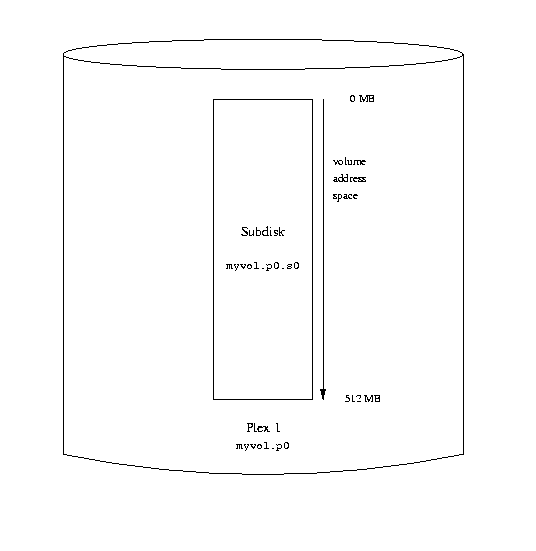
A simple Vinum volume
This figure, and the ones which follow, represent a volume, which contains the
plexes, which in turn contain the subdisks. In this trivial example, the volume
contains one plex, and the plex contains one subdisk.
This particular volume has no specific advantage over a conventional disk
partition. It contains a single plex, so it is not redundant. The plex
contains a single subdisk, so there is no difference in storage allocation from
a conventional disk partition. The following sections illustrate various more
interesting configuration methods.
Increased resilience: mirroring
The resilience of a volume can be increased either by mirroring or by using
RAID-5 plexes. When laying out a mirrored volume, it is important to ensure
that the subdisks of each plex are on different drives, so that a drive failure
will not take down both plexes. The following configuration mirrors a volume:
drive b device /dev/da4h
volume mirror
plex org concat
sd length 512m drive a
plex org concat
sd length 512m drive b
In this example, it was not necessary to specify a definition of drive a
again, since Vinum keeps track of all objects in its configuration database.
After processing this definition, the configuration looks like:
Drives: 2 (4 configured)
Volumes: 2 (4 configured)
Plexes: 3 (8 configured)
Subdisks: 3 (16 configured)
D a State: up Device /dev/da3h Avail: 1549/2573 MB (60%)
D b State: up Device /dev/da4h Avail: 2061/2573 MB (80%)
V myvol State: up Plexes: 1 Size: 512 MB
V mirror State: up Plexes: 2 Size: 512 MB
P myvol.p0 C State: up Subdisks: 1 Size: 512 MB
P mirror.p0 C State: up Subdisks: 1 Size: 512 MB
P mirror.p1 C State: initializing Subdisks: 1 Size: 512 MB
S myvol.p0.s0 State: up PO: 0 B Size: 512 MB
S mirror.p0.s0 State: up PO: 0 B Size: 512 MB
S mirror.p1.s0 State: empty PO: 0 B Size: 512 MB
The following figure shows the structure graphically.
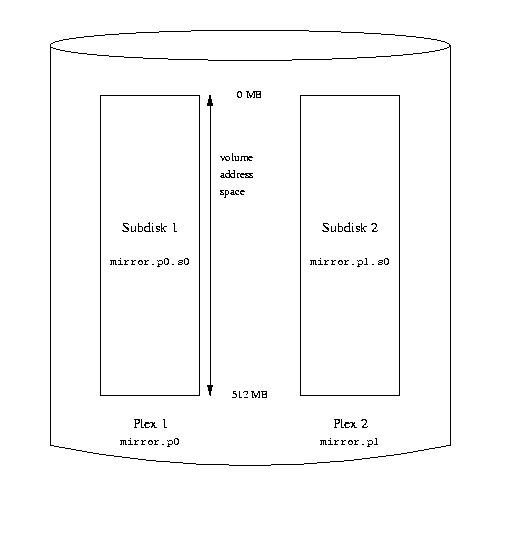
A mirrored Vinum volume
In this example, each plex contains the full 512 MB of address space. As in the
previous example, each plex contains only a single subdisk.
Optimizing performance
The mirrored volume in the previous example is more resistant to failure than an
unmirrored volume, but its performance is less: each write to the volume
requires a write to both drives, using up a greater proportion of the total disk
bandwidth. Performance considerations demand a different approach: instead of
mirroring, the data is striped across as many disk drives as possible. The
following configuration shows a volume with a plex striped across four disk
drives:
drive c device /dev/da5h
drive d device /dev/da6h
volume stripe
plex org striped 512k
sd length 128m drive a
sd length 128m drive b
sd length 128m drive c
sd length 128m drive d
As before, it is not necessary to define the drives which are already known to
Vinum. After processing this definition, the configuration looks like:
Drives: 4 (4 configured)
Volumes: 3 (4 configured)
Plexes: 4 (8 configured)
Subdisks: 7 (16 configured)
D a State: up Device /dev/da3h Avail: 1421/2573 MB (55%)
D b State: up Device /dev/da4h Avail: 1933/2573 MB (75%)
D c State: up Device /dev/da5h Avail: 2445/2573 MB (95%)
D d State: up Device /dev/da6h Avail: 2445/2573 MB (95%)
V myvol State: up Plexes: 1 Size: 512 MB
V mirror State: up Plexes: 2 Size: 512 MB
V striped State: up Plexes: 1 Size: 512 MB
P myvol.p0 C State: up Subdisks: 1 Size: 512 MB
P mirror.p0 C State: up Subdisks: 1 Size: 512 MB
P mirror.p1 C State: initializing Subdisks: 1 Size: 512 MB
P striped.p1 State: up Subdisks: 1 Size: 512 MB
S myvol.p0.s0 State: up PO: 0 B Size: 512 MB
S mirror.p0.s0 State: up PO: 0 B Size: 512 MB
S mirror.p1.s0 State: empty PO: 0 B Size: 512 MB
S striped.p0.s0 State: up PO: 0 B Size: 128 MB
S striped.p0.s1 State: up PO: 512 kB Size: 128 MB
S striped.p0.s2 State: up PO: 1024 kB Size: 128 MB
S striped.p0.s3 State: up PO: 1536 kB Size: 128 MB
This volume is represented in the following figure. The darkness of the stripes
indicates the position within the plex address space: the lightest stripes come
first, the darkest last.
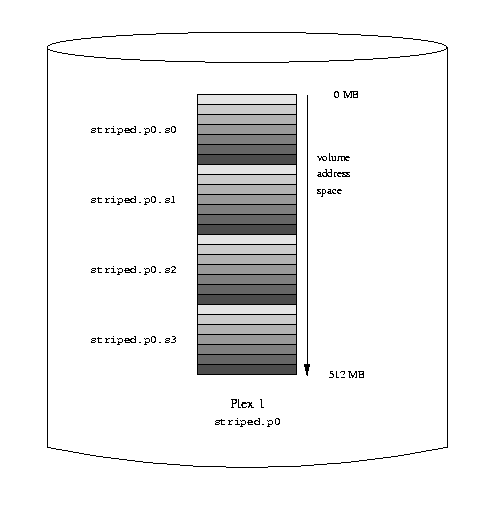
A striped Vinum volume
Increased resilience: RAID-5
The alternative approach to resilience is RAID-5. A RAID-5 configuration might
look like:
drive e device /dev/da6h
volume raid5
plex org raid5 512k
sd length 128m drive a
sd length 128m drive b
sd length 128m drive c
sd length 128m drive d
sd length 128m drive e
Although this plex has five subdisks, its size is the same as the plexes in the
other examples, since the equivalent of one subdisk is used to store parity
information. After processing the configuration, the system configuration is:
Drives: 5 (8 configured)
Volumes: 4 (4 configured)
Plexes: 5 (8 configured)
Subdisks: 12 (16 configured)
D a State: up Device /dev/da3h Avail: 1293/2573 MB (50%)
D b State: up Device /dev/da4h Avail: 1805/2573 MB (70%)
D c State: up Device /dev/da5h Avail: 2317/2573 MB (90%)
D d State: up Device /dev/da6h Avail: 2317/2573 MB (90%)
D e State: up Device /dev/da6h Avail: 2445/2573 MB (95%)
V myvol State: up Plexes: 1 Size: 512 MB
V mirror State: up Plexes: 2 Size: 512 MB
V striped State: up Plexes: 1 Size: 512 MB
V raid5 State: up Plexes: 1 Size: 512 MB
P myvol.p0 C State: up Subdisks: 1 Size: 512 MB
P mirror.p0 C State: up Subdisks: 1 Size: 512 MB
P mirror.p1 C State: initializing Subdisks: 1 Size: 512 MB
P striped.p0 S State: up Subdisks: 1 Size: 512 MB
P raid5.p0 R State: up Subdisks: 1 Size: 512 MB
S myvol.p0.s0 State: up PO: 0 B Size: 512 MB
S mirror.p0.s0 State: up PO: 0 B Size: 512 MB
S mirror.p1.s0 State: empty PO: 0 B Size: 512 MB
S striped.p0.s0 State: up PO: 0 B Size: 128 MB
S striped.p0.s1 State: up PO: 512 kB Size: 128 MB
S striped.p0.s2 State: up PO: 1024 kB Size: 128 MB
S striped.p0.s3 State: up PO: 1536 kB Size: 128 MB
S raid5.p0.s0 State: init PO: 0 B Size: 128 MB
S raid5.p0.s1 State: init PO: 512 kB Size: 128 MB
S raid5.p0.s2 State: init PO: 1024 kB Size: 128 MB
S raid5.p0.s3 State: init PO: 1536 kB Size: 128 MB
S raid5.p0.s4 State: init PO: 1536 kB Size: 128 MB
The following figure represents this volume graphically.

A RAID-5 Vinum volume
As with striped plexes, the darkness of the stripes indicates the position
within the plex address space: the lightest stripes come first, the darkest
last. The completely black stripes are the parity stripes.
On creation, RAID-5 plexes are in the init state: before they can be
used, the parity data must be created. Vinum currently initializes RAID-5
plexes by writing binary zeros to all subdisks, though a conceivable alternative
would be to rebuild the parity blocks, which would allow better recovery of
crashed plexes.
Resilience and performance
With sufficient hardware, it is possible to build volumes which show both
increased resilience and increased performance compared to standard UNIX
partitions. Mirrored disks will always give better performance than RAID-5, so
a typical configuration file might be:
volume raid10
plex org striped 512k
sd length 102480k drive a
sd length 102480k drive b
sd length 102480k drive c
sd length 102480k drive d
sd length 102480k drive e
plex org striped 512k
sd length 102480k drive c
sd length 102480k drive d
sd length 102480k drive e
sd length 102480k drive a
sd length 102480k drive b
The subdisks of the second plex are offset by two drives from those of the first
plex: this helps ensure that writes do not go to the same subdisks even if a
transfer goes over two drives.
The following figure represents the structure of this volume.
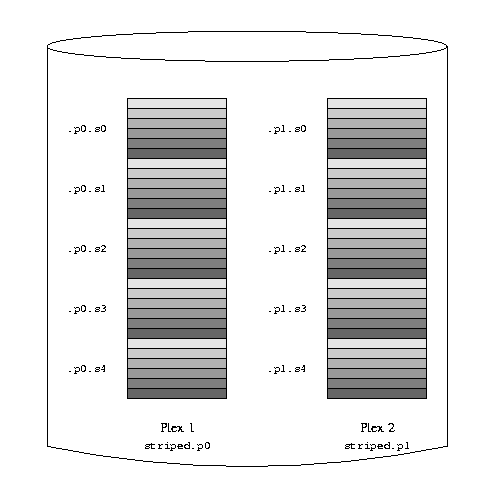
A mirrored, striped Vinum volume
Object naming
As described above, Vinum assigns default names to plexes and subdisks, although
they may be overridden. Overriding the default names is not recommended:
experience with the VERITAS volume manager, which allows arbitary naming of
objects, has shown that this flexibility does not bring a significant advantage,
and it can cause confusion.
Names may contain any non-blank character, but it is recommended to restrict
them to letters, digits and the underscore characters. The names of volumes,
plexes and subdisks may be up to 64 characters long, and the names of drives may
up to 32 characters long.
Vinum objects are assigned device nodes in the hierarchy /dev/vinum. The
configuration shown above would cause Vinum to create the following device
nodes:
-
The control devices /dev/vinum/control and /dev/vinum/controld,
which are used by vinum(8) and the Vinum dæmon respectively.
-
Block and character device entries for each volume. These are the main devices
used by Vinum. The block device names are the name of the volume, while the
character device names follow the BSD tradition of prepending the letter
r to the name. Thus the configuration above would include the block
devices /dev/vinum/myvol, /dev/vinum/mirror,
/dev/vinum/striped, /dev/vinum/raid5 and /dev/vinum/raid10,
and the character devices /dev/vinum/rmyvol, /dev/vinum/rmirror,
/dev/vinum/rstriped, /dev/vinum/rraid5 and
/dev/vinum/rraid10. There is obviously a problem here: it is possible to
have two volumes called r and rr, but there will be a conflict
creating the device node /dev/vinum/rr: is it a character device for
volume r or a block device for volume rr? Currently Vinum does
not address this conflict: the first-defined volume will get the name.
-
A directory /dev/vinum/drive with entries for each drive. These entries
are in fact symbolic links to the corresponding disk nodes.
-
A directory /dev/vinum/volume with entries for each volume. It contains
subdirectories for each plex, which in turn contain subdirectories for their
component subdisks.
-
The directories /dev/vinum/plex and /dev/vinum/sd,
/dev/vinum/rsd, which contain block device nodes for each plex and block
and character device nodes respectively for subdisk.
For example, consider the following configuration file:
drive drive1 device /dev/sd1h
drive drive2 device /dev/sd2h
drive drive3 device /dev/sd3h
drive drive4 device /dev/sd4h
volume s64 setupstate
plex org striped 64k
sd length 100m drive drive1
sd length 100m drive drive2
sd length 100m drive drive3
sd length 100m drive drive4
After processing this file, vinum(8) creates the following structure in
/dev/vinum:
brwx------ 1 root wheel 25, 0x40000001 Apr 13 16:46 Control
brwx------ 1 root wheel 25, 0x40000002 Apr 13 16:46 control
brwx------ 1 root wheel 25, 0x40000000 Apr 13 16:46 controld
drwxr-xr-x 2 root wheel 512 Apr 13 16:46 drive
drwxr-xr-x 2 root wheel 512 Apr 13 16:46 plex
crwxr-xr-- 1 root wheel 91, 2 Apr 13 16:46 rs64
drwxr-xr-x 2 root wheel 512 Apr 13 16:46 rsd
drwxr-xr-x 2 root wheel 512 Apr 13 16:46 rvol
brwxr-xr-- 1 root wheel 25, 2 Apr 13 16:46 s64
drwxr-xr-x 2 root wheel 512 Apr 13 16:46 sd
drwxr-xr-x 3 root wheel 512 Apr 13 16:46 vol
/dev/vinum/drive:
total 0
lrwxr-xr-x 1 root wheel 9 Apr 13 16:46 drive1 -> /dev/sd1h
lrwxr-xr-x 1 root wheel 9 Apr 13 16:46 drive2 -> /dev/sd2h
lrwxr-xr-x 1 root wheel 9 Apr 13 16:46 drive3 -> /dev/sd3h
lrwxr-xr-x 1 root wheel 9 Apr 13 16:46 drive4 -> /dev/sd4h
/dev/vinum/plex:
total 0
brwxr-xr-- 1 root wheel 25, 0x10000002 Apr 13 16:46 s64.p0
/dev/vinum/rsd:
total 0
crwxr-xr-- 1 root wheel 91, 0x20000002 Apr 13 16:46 s64.p0.s0
crwxr-xr-- 1 root wheel 91, 0x20100002 Apr 13 16:46 s64.p0.s1
crwxr-xr-- 1 root wheel 91, 0x20200002 Apr 13 16:46 s64.p0.s2
crwxr-xr-- 1 root wheel 91, 0x20300002 Apr 13 16:46 s64.p0.s3
/dev/vinum/rvol:
total 0
crwxr-xr-- 1 root wheel 91, 2 Apr 13 16:46 s64
/dev/vinum/sd:
total 0
brwxr-xr-- 1 root wheel 25, 0x20000002 Apr 13 16:46 s64.p0.s0
brwxr-xr-- 1 root wheel 25, 0x20100002 Apr 13 16:46 s64.p0.s1
brwxr-xr-- 1 root wheel 25, 0x20200002 Apr 13 16:46 s64.p0.s2
brwxr-xr-- 1 root wheel 25, 0x20300002 Apr 13 16:46 s64.p0.s3
/dev/vinum/vol:
total 1
brwxr-xr-- 1 root wheel 25, 2 Apr 13 16:46 s64
drwxr-xr-x 3 root wheel 512 Apr 13 16:46 s64.plex
/dev/vinum/vol/s64.plex:
total 1
brwxr-xr-- 1 root wheel 25, 0x10000002 Apr 13 16:46 s64.p0
drwxr-xr-x 2 root wheel 512 Apr 13 16:46 s64.p0.sd
/dev/vinum/vol/s64.plex/s64.p0.sd:
total 0
brwxr-xr-- 1 root wheel 25, 0x20000002 Apr 13 16:46 s64.p0.s0
brwxr-xr-- 1 root wheel 25, 0x20100002 Apr 13 16:46 s64.p0.s1
brwxr-xr-- 1 root wheel 25, 0x20200002 Apr 13 16:46 s64.p0.s2
brwxr-xr-- 1 root wheel 25, 0x20300002 Apr 13 16:46 s64.p0.s3
Although it is recommended that plexes and subdisks should not be allocated
specific names, Vinum drives must be named. This makes it possible to move a
drive to a different location and still recognize it automatically. Drive names
may be up to 32 characters long.
Creating file systems
Volumes appear to the system to be identical to disks, with one exception.
Unlike UNIX drives, Vinum does not partition volumes, which thus do not contain
a partition table. This has required modification to some disk utilities,
notably newfs, which previously tried to interpret the last letter of a
Vinum volume name as a partition identifier. For example, a disk drive may have
a name like /dev/wd0a or /dev/da2h. These names represent the
first partition (a) on the first (0) IDE disk (wd) and the eight
partition (h) on the third (2) SCSI disk (da) respectively. By
contrast, a Vinum volume may be called /dev/vinum/concat.
Normally, newfs(8) interprets the name of the disk and complains if it
cannot understand it. For example:
# newfs /dev/vinum/concat
newfs: /dev/vinum/concat: can't figure out file system partition
In order to create a file system on this volume, use the -v option to
newfs(8):
# newfs -v /dev/vinum/concat
Startup
Vinum stores configuration information on the disk slices in essentially the
same form as in the configuration files. When reading from the configuration
database, Vinum recognizes a number of keywords which are not allowed in the
configuration files. For example, a disk configuration might contain:
volume myvol state up
volume bigraid state down
plex name myvol.p0 state up org concat vol myvol
plex name myvol.p1 state up org concat vol myvol
plex name myvol.p2 state init org striped 512b vol myvol
plex name bigraid.p0 state initializing org raid5 512b vol bigraid
sd name myvol.p0.s0 drive a plex myvol.p0 state up len 1048576b driveoffset 265
b plexoffset 0b
sd name myvol.p0.s1 drive b plex myvol.p0 state up len 1048576b driveoffset 265
b plexoffset 1048576b
sd name myvol.p1.s0 drive c plex myvol.p1 state up len 1048576b driveoffset 265
b plexoffset 0b
sd name myvol.p1.s1 drive d plex myvol.p1 state up len 1048576b driveoffset 265
b plexoffset 1048576b
sd name myvol.p2.s0 drive a plex myvol.p2 state init len 524288b driveoffset 10
48841b plexoffset 0b
sd name myvol.p2.s1 drive b plex myvol.p2 state init len 524288b driveoffset 10
48841b plexoffset 524288b
sd name myvol.p2.s2 drive c plex myvol.p2 state init len 524288b driveoffset 10
48841b plexoffset 1048576b
sd name myvol.p2.s3 drive d plex myvol.p2 state init len 524288b driveoffset 10
48841b plexoffset 1572864b
sd name bigraid.p0.s0 drive a plex bigraid.p0 state initializing len 4194304b d
riveoffset 1573129b plexoffset 0b
sd name bigraid.p0.s1 drive b plex bigraid.p0 state initializing len 4194304b d
riveoffset 1573129b plexoffset 4194304b
sd name bigraid.p0.s2 drive c plex bigraid.p0 state initializing len 4194304b d
riveoffset 1573129b plexoffset 8388608b
sd name bigraid.p0.s3 drive d plex bigraid.p0 state initializing len 4194304b d
riveoffset 1573129b plexoffset 12582912b
sd name bigraid.p0.s4 drive e plex bigraid.p0 state initializing len 4194304b d
riveoffset 1573129b plexoffset 16777216b
The obvious differences here are the presence of explicit location information
and naming (both of which are also allowed, but discouraged, for use by the
user) and the information on the states (which are not available to the user).
Vinum does not store information about drives in the configuration information:
it finds the drives by scanning the configured disk drives for partitions with a
Vinum label. This enables Vinum to identify drives correctly even if they have
been assigned different UNIX drive IDs.
At system startup, Vinum reads the configuration database from one of the Vinum
drives. Under normal circumstances, each drive contains an identical copy of
the configuration database, so it does not matter which drive is read. After a
crash, however, Vinum must determine which drive was updated most recently and
read the configuration from this drive.
Performance issues
This document shows the result of some initial performance measurements.
Another set of results, on more modern disk hardware, can be found at http://www.shub-internet.org/brad/FreeBSD/vinum.html.
Both sets of results show that the performance is very close to what could be
expected from the underlying disk driver performing the same operations as Vinum
performs: in other words, the overhead of Vinum itself is negligible. This does
not mean that Vinum has perfect performance: the choice of requests has a strong
impact on the overall subsystem performance, and there are some known areas
which could be improved upon. In addition, the user can influence performance
by the design of the volumes.
The following sections examine some factors which influence performance.
Note: Most of the performance measurements were done on some very old
pre-SCSI-1 disk drives. The absolute performance is correspondingly poor. The
intention of the following graphs is to show relative performance, not absolute
performance.
The influence of stripe size
In striped and RAID-5 plexes, the stripe size has a significant influence on
performance. In all plex structures except a single-subdisk plex (which by
definition is concatenated), the possibility exists that a single transfer to or
from a volume will be remapped into more than one physical I/O request. This is
never desirable, since the average latency for multiple transfers is always
larger than the average latency for single transfers to the same kind of disk
hardware. Spindle synchronization does not help here, since there is no
deterministic relationship between the positions of the data blocks on the
different disks. Within the bounds of the current BSD I/O architecture (maximum
transfer size 128 kB) and current disk hardware, this increase in latency can
easily offset any speed increase in the transfer.
In the case of a concatenated plex, this remapping occurs only when a request
overlaps a subdisk boundary. In a striped or RAID-5 plex, however, the
probability is an inverse function of the stripe size. For this reason, a
stripe size of 256 kB appears to be optimum: it is small enough to create a
relatively random mapping of file system hot spots to individual disks, and
large enough to ensure than 95% of all transfers involve only a single data
subdisk. The following graph shows the effect of stripe size on read and write
performance, obtained with rawio. This measurement used
eight concurrent processes to access volumes with striped plexes with different
stripe sizes. The graph shows the disadvantage of small stripe sizes, which can
cause a significant performance degradation even compared to a single disk.
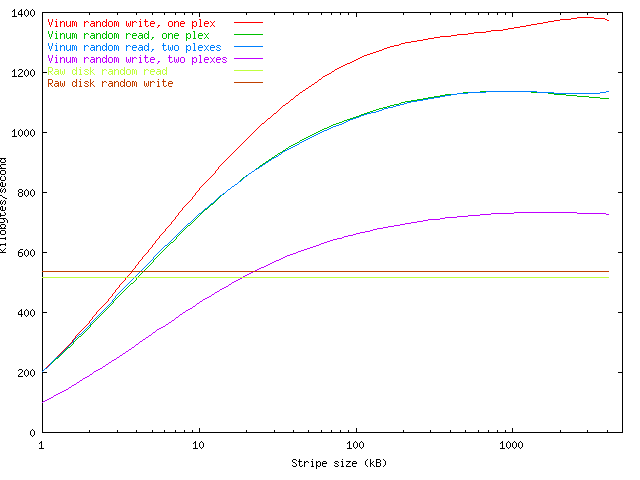
The influence of stripe size and mirroring
The influence of RAID-1 mirroring
Mirroring has different effects on read and write throughput. A write to a
mirrored volume causes writes to each plex, so write performance is less than
for a non-mirrored volume. A read from a mirrored volume, however, reads from
only one plex, so read performance can improve.
There are two different scenarios for these performance changes, depending on
the layout of the subdisks comprising the volume. Two basic possiblities exist
for a mirrored, striped plex.
One disk per subdisk
The optimum layout, both for reliability and for performance, is to have each
subdisk on a separate disk. An example might be the following configuration,
similar to the configuration shown above.
volume raid10
plex org striped 512k
sd length 102480k drive a
sd length 102480k drive b
sd length 102480k drive c
sd length 102480k drive d
plex org striped 512k
sd length 102480k drive e
sd length 102480k drive f
sd length 102480k drive g
sd length 102480k drive h
In this case, the volume is spread over a total of eight disks. This has the
following effects:
-
Read access: by default, read accesses will alternate across the two plexes,
giving a performance improvement close to 100%.
-
Write access: writes must be performed to both disks, doubling the bandwidth
requirement. Since the available bandwidth is also double, there should be
little difference in througput.
At present, due to lack of hardware, no tests have been made of this
configuration.
Both plexes on the same disks
An alternative layout is to spread the subdisks of each plex over the same
disks:
volume raid10
plex org striped 512k
sd length 102480k drive a
sd length 102480k drive b
sd length 102480k drive c
sd length 102480k drive d
plex org striped 512k
sd length 102480k drive c
sd length 102480k drive d
sd length 102480k drive a
sd length 102480k drive b
This has the following effects:
-
Read access: by default, read accesses will alternate across the two plexes.
Since there is no increase in bandwidth, there will be little difference in
performance through the second plex.
-
Write access: writes must be performed to both disks, doubling the bandwidth
requirement. In this case, the bandwidth has not increase, so write throughput
will decrease by approximately 50%.
The previous figure also shows the effect of mirroring in this manner. The
results are very close to the theoretical predictions.
The influence of request size
As seen above, the throughput of a disk subsystem is the
sum of the latency (the time taken to position the disk hardware over the
correct part of the disk) and the time to transfer the data to or from the disk.
Clearly the throughput is strongly dependent on the size of the transfer, as the
following graph shows.
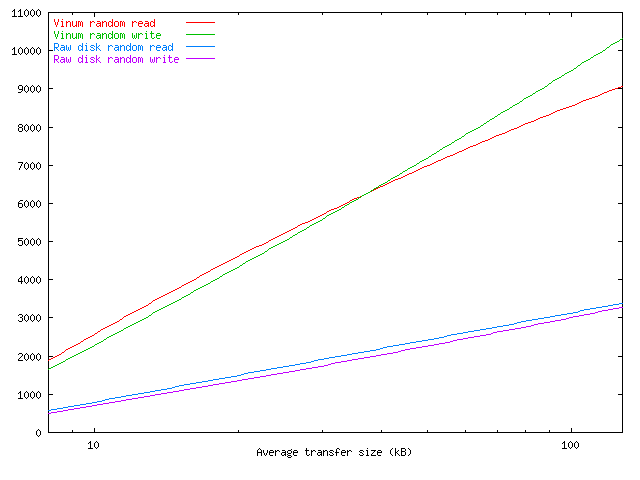
Throughput as function of transfer size
Unfortunately, there is little that can be done to influence the transfer size.
In FreeBSD, it tends to be closer to 10 kB than to 30 kB.
The influence of concurrency
Vinum aims to give best performance for a large number of concurrent processes
performing random access on a volume. The following graph shows the
relationship between number of processes and throughput for a raw disk volume
and a Vinum volume striped over four such disks with between one and 128
concurrent processes with an average transfer size of 16 kB. The actual
transfers varied between 512 bytes and 32 kB, which roughly corresponds to UFS
usage.
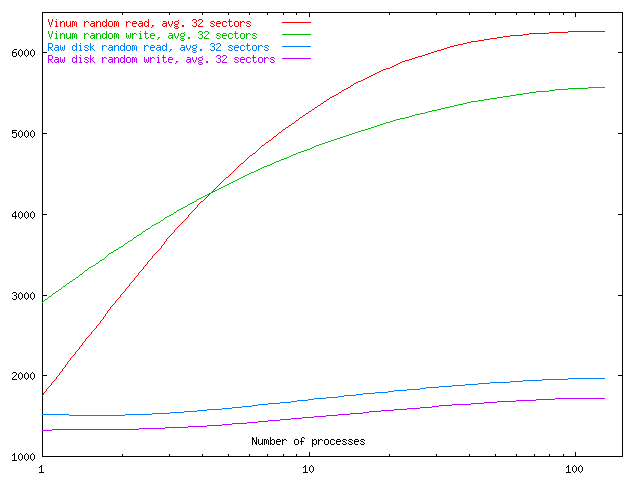
Concurrent random access with 32 sector transfers
This graph clearly shows the differing effects of multiple concurrent processes
on the Vinum volume and the relative lack of effect on a single disk. The
single disk is saturated even with one process, while Vinum shows a continual
throughput improvement with up to 128 processes, by which time it has
practically leveled off.
The influence of request structure
For concatenated and striped plexes, Vinum creates request structures which map
directly to the user-level request buffers. The only additional overhead is the
allocation of the request structure, and the possibility of improvement is
correspondingly small.
With RAID-5 plexes, the picture is very different. The strategic choices
described above work well when the total request size is less than the stripe
width. By contrast, consider the following transfer of 32.5 kB:
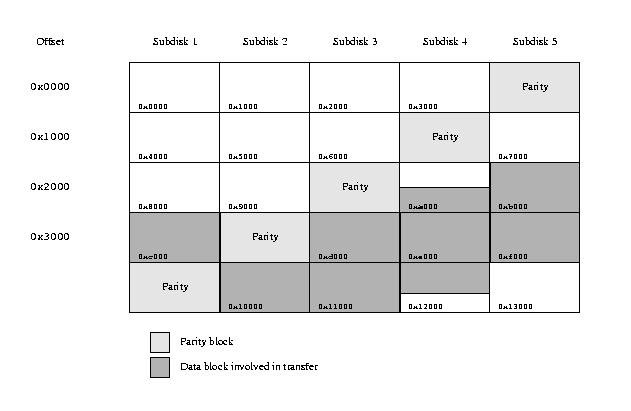
A sample RAID-5 transfer
An optimum approach to reading this data performs a total of 5 I/O operations,
one on each subdisk. By contrast, Vinum treats this transfer as three separate
transfers, one per stripe, and thus performs a total of 9 I/O transfers.
In practice, this inefficiency should not cause any problems: as discussed
above, the optimum stripe size is larger than the maximum transfer size, so this
situation does not arise when an appropriate stripe size is chosen.

RAID-5 performance against stripe size
These considerations are shown in the following graph, which clearly shows the
RAID-5 tradeoffs:
-
The RAID-5 write throughput is approximately half of the RAID-1 throughput in
the graph showing mirroring, and one-quarter of the
write throughput of a striped plex.
-
The read throughput is similar to that of striped volume of the same size.
Although the random access performance increases continually with increasing
stripe size, the sequential access performance peaks at about 20 kB for writes
and 35 kB for reads. This effect has not yet been adequately explained, but may
be due to the nature of the test (8 concurrent processes writing the same data
at the same time).
The implementation
At the time of writing, some aspects of the implementation are still subject to
change. This section examines some of the more interesting tradeoffs in the
implementation. Where the driver fits
To the operating system, Vinum
looks like a block device, so it is normally be accessed as a block device.
Instead of operating directly on the device, it creates new requests and passes
them to the real device drivers. Conceptually it could pass them to other Vinum
devices, though this usage makes no sense and would probably cause problems.
The following figure, borrowed from ``The Design and Implementation of the
4.4BSD Operating System'', by McKusick et. al., shows the standard 4.4BSD I/O
structure:
This figure is © 1996 Addison-Wesley, and is reproduced with permission.
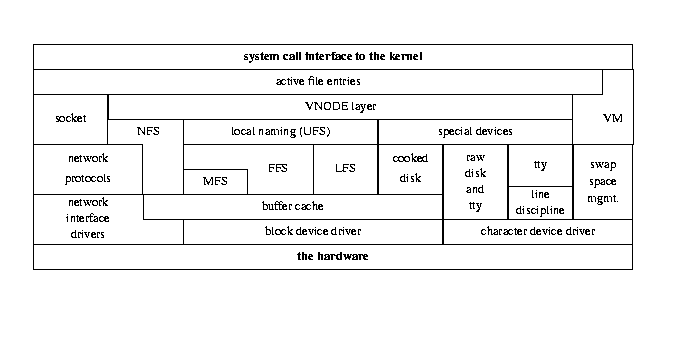
Kernel I/O structure, after McKusick et. al.
The following figure shows the I/O structure in FreeBSD after installing Vinum.
Apart from the effect of Vinum, it shows the gradual lack of distinction between
block and character devices that has occurred since the release of 4.4BSD:
FreeBSD implements disk character devices in the corresponding block driver.
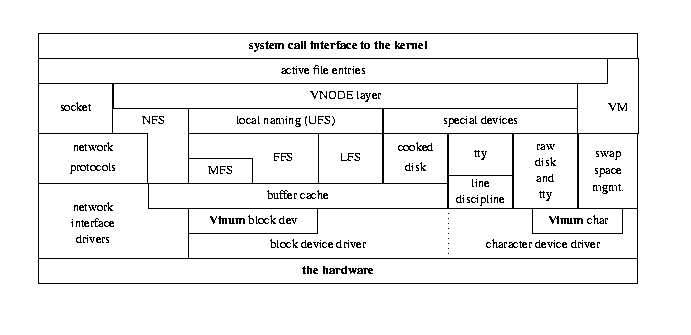
Kernel I/O structure with Vinum
Design limitations
Vinum was intended to have as few arbitrary limits as possible consistent with
an efficient implementation. Nevertheless, a number of limits were imposed in
the interests of efficiency, mainly in connection with the device minor number
format. These limitations will no longer be relevant after the introduction of
a device file system.
|
Restriction
|
Reasoning
|
|
Fixed maximum number of volumes per system.
|
In order to maintain compatibility with other versions of UNIX, it was
considered desirable to keep the device numbers of volume in the traditional 8+8
format (8 bits major number, 8 bits minor number). This restricts the number of
volumes to 256. In view of the fact that Vinum provides for larger
volumes than disks, and current machines are seldom able to control more than 64
disk drives, this restriction seems unlikely to become severe for some
years to come.
|
|
Fixed number of plexes per volume
|
Plexes supply redundancy according to RAID-1. For this purpose, two plexes are
sufficient under normal circumstances. For rebuilding and archival purposes,
additional plexes can be useful, but it is difficult to find a situation where
more than four plexes are necessary or useful. On the other hand, additional
plexes beyond four bring little advantage for reading and a significant
disadvantage for writing. I believe that eight plexes are ample.
|
|
Fixed maximum number of subdisks per plex.
|
For similar reasons, the number of subdisks was limited to 256. It seldom
makes sense to have more than about 10 subdisks per plex, so this restriction
does not currently appear severe. There is no specific overall limitation on
the number of subdisks.
|
|
Minimum device size
|
A device must contain at least 1 MB of storage. This assumption makes it
possible to dispense with some boundary condition checks. Vinum
requires 133 kB of disk space to store the header and configuration information,
so this restriction does not appear serious.
|
Memory allocation
In order to perform its functionality, Vinum allocates a large number of dynamic
data structures. Currently these structures are allocated by calling kernel
malloc. This is a potential problem, since malloc interacts
with the virtual memory system and may trigger a page fault. The potential for
a deadlock exists if the page fault requires a transfer to a Vinum volume. It
is probable that Vinum will modify its allocation strategy by reserving a small
number of buffers when it starts and using these if a malloc request
fails.
To cache or not to cache
Traditionally, UNIX block devices are accessed from the file system via caching
routines such as bread and bwrite. It is also possible to access
them directly, but this facility is seldom used. The use of caching enables
significant improvements in performance.
Vinum does not cache the data it passes to the lower-level drivers. It would
also seem counterproductive to do so: the data is available in cache already,
and the only effect of caching it a second time would be to use more memory,
thus causing more frequent cache misses.
RAID-5 plexes pose a problem to this reasoning. A RAID-5 write normally first
reads the parity block, so there might be some advantage in caching at least the
parity blocks. This issue has been deferred for further study.
Access optimization
The algorithms for RAID-5 access are surprisingly complicated and require a
significant amount of temporary data storage. To achieve reasonable
performance, they must take error recovery strategies into account at a low
level. A RAID 5 access can require one or more of the following actions:
-
Normal read. All participating subdisks are up, and the transfer can be
made directly to the user buffer.
-
Recovery read. One participating subdisk is down. To recover data, all
the other subdisks, including the parity subdisk, must be read. The data is
recovered by exclusive-oring all the other blocks.
-
Normal write. All the participating subdisks are up. This write proceeds
in four phases:
-
Read the old contents of each block and the parity block.
-
``Remove'' the old contents from the parity block with exclusive or.
-
``Insert'' the new contents of the block in the parity block, again with
exclusive or.
-
Write the new contents of the data blocks and the parity block. The data block
transfers can be made directly from the user buffer.
-
Degraded write where the data block is not available. This requires the
following steps:
-
Read in all the other data blocks, excluding the parity block.
-
Recreate the parity block from the other data blocks and the data to be written.
-
Write the parity block.
-
Parityless write, a write where the parity block is not available. This
is in fact the simplest: just write the data blocks. This can proceed directly
from the user buffer.
Combining access strategies
In practice, a transfer request may combine the actions above. In particular:
-
A read request may request reading both available data (normal read) and
non-available data (recovery read). This can be a problem if the address ranges
of the two reads do not coincide: the normal read must be extended to cover the
address range of the recovery read, and must thus be performed out of malloced
memory.
-
Combination of degraded data block write and normal write. The address ranges
of the reads may also need to be extended to cover all participating blocks.
An exception exists when the transfer is shorter than the width of the stripe
and is spread over two subdisks. In this case, the subdisk addresses do not
overlap, so they are effectively two separate requests.
Examples
The following examples illustrate these concepts:

A sample RAID-5 transfer
The figure above illustrates a number of typical points about RAID-5 transfers.
It shows the beginning of a plex with five subdisks and a stripe size of 4 kB.
The shaded area shows the area involved in a transfer of 4.5 kB (9 sectors),
starting at offset 0xa800 in the plex. A read of this area generates
two requests to the lower-level driver: 4 sectors from subdisk 4, starting at
offset 0x2800, and 5 sectors from subdisk 5, starting at offset
0x2000.
Writing this area is significantly more complicated. From a programming
standpoint, the simplest approach is to consider the transfers individually.
This would create the following requests:
-
Read the old contents of 4 sectors from subdisk 4, starting at offset 0x2800.
-
Read the old contents of 4 sectors from subdisk 3 (the parity disk), starting at
offset 0x2800.
-
Perform an exclusive OR of the data read from subdisk 4 with the data read from
subdisk 3, storing the result in subdisk 3's data buffer. This effectively
``removes'' the old data from the parity block.
-
Perform an exclusive OR of the data to be written to subdisk 4 with the data
read from subdisk 3, storing the result in subdisk 3's data buffer. This
effectively ``adds'' the new data to the parity block.
-
Write the new data to 4 sectors of subdisk 4, starting at offset 0x2800.
-
Write 4 sectors of new parity data to subdisk 3 (the parity disk), starting at
offset 0x2800.
-
Read the old contents of 5 sectors from subdisk 5, starting at offset 0x2000.
-
Read the old contents of 5 sectors from subdisk 3 (the parity disk), starting at
offset 0x2000.
-
Perform an exclusive OR of the data read from subdisk 5 with the data read from
subdisk 3, storing the result in subdisk 3's data buffer. This effectively
``removes'' the old data from the parity block.
-
Perform an exclusive OR of the data to be written to subdisk 5 with the data
read from subdisk 3, storing the result in subdisk 3's data buffer. This
effectively ``adds'' the new data to the parity block.
-
Write the new data to 5 sectors of subdisk 5, starting at offset 0x2000.
-
Write 5 sectors of new parity data to subdisk 3 (the parity disk), starting at
offset 0x2000.
This approach is clearly suboptimal. The operation involves a total of 8 I/O
operations and transfers 36 sectors of data. In addition, the two halves of the
operation block each other, since each must access the same data on the parity
subdisk. Vinum optimizes this access in the following manner:
-
Read the old contents of 4 sectors from subdisk 4, starting at offset 0x2800.
-
Read the old contents of 5 sectors from subdisk 5, starting at offset 0x2000.
-
Read the old contents of 8 sectors from subdisk 3 (the parity disk), starting at
offset 0x2000. This represents the complete parity block for the stripe.
-
Perform an exclusive OR of the data read from subdisk 4 with the data read from
subdisk 3, starting at offset 0x800 into the buffer, and storing the
result in the same place in subdisk 3's data buffer.
-
Perform an exclusive OR of the data read from subdisk 5 with the data read from
subdisk 3, starting at the beginning of the buffer, and storing the result in
the same place in subdisk 3's data buffer offset.
-
Perform an exclusive OR of the data to be written to subdisk 4 with the modified
parity block, starting at offset 0x800 into the buffer, and storing the
result in the same place in subdisk 3's data buffer.
-
Perform an exclusive OR of the data to be written to subdisk 5 with the modified
parity block, starting at the beginning of the buffer, and storing the result in
the same place in subdisk 3's data buffer offset.
-
Write the new data to 4 sectors of subdisk 4, starting at offset 0x2800.
-
Write the new data to 5 sectors of subdisk 5, starting at offset 0x2000.
-
Write the 8 sectors of new parity data to subdisk 3 (the parity disk), starting at
offset 0x2000.
This is still a lot of work, but by comparison with the non-optimized version,
the number of I/O operations has been reduced to 6, and the number of sectors
transferred is reduced by 2. The larger the overlap, the greater the saving.
If the request had been for a total of 17 sectors, starting at offset
0x9800, the unoptimized version would have performed 12 I/O operations
and moved a total of 68 sectors, while the optimized version would perform 8 I/O
operations and move a total of 50 sectors.
Degraded read
The following figure illustrates the situation where a data subdisk fails, in
this case subdisk 4.
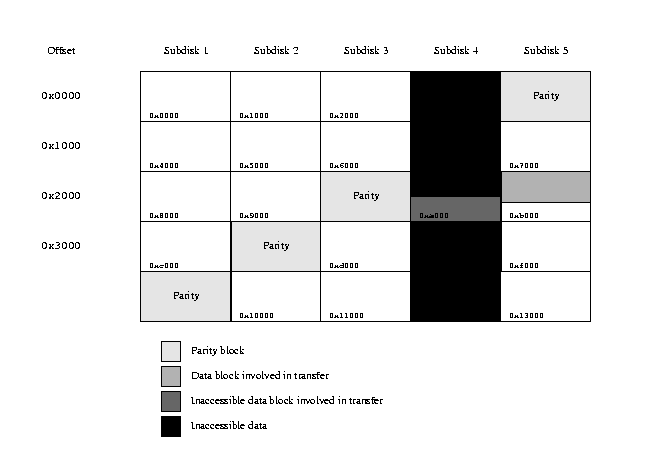
RAID-5 transfer with inaccessible data block
In this case, reading the data from subdisk 5 is trivial. Recreating the data
from subdisk 4, however, requires reading all the remaining subdisks.
Specifically,
-
Read 4 sectors each from subdisks 1, 2 and 3, starting at offset 0x2800
in each case.
-
Read 8 sectors from subdisk 5, starting at offset 0x2800.
-
Clear the user buffer area for the data corresponding to subdisk 4.
-
Perform an ``exclusive or'' operation on this data buffer with data from
subdisks 1, 2, 3, and the last four sectors of the data from subdisk 5.
-
Transfer the first 5 sectors of data from the data buffer for subdisk 5 to the
corresponding place in the user data buffer.
Degraded write
There are two different scenarios to be considered in a degraded write.
Referring to the previous example, the operations required are a mixture of
normal write (for subdisk 5) and degraded write (for subdisk 4). In detail, the
operations are:
-
Read 4 sectors each from subdisks 1 and 2, starting at offset 0x2800,
into temporary storage.
-
Read 5 sectors from subdisk 3 (parity block), starting at offset 0x2000,
into the beginning of an 8 sector temporary storage buffer.
-
Clear the last 3 sectors of the parity block.
-
Read 8 sectors from subdisk 5, starting at offset 0x2000, into temporary
storage.
-
``Remove'' the first 5 sectors of subdisk 5 data from the parity block with
exclusive or.
-
Rebuild the last 3 sectors of the parity block by exclusive or of the
corresponding data from subdisks 1, 2, 5 and the data to be written for subdisk
4.
-
Write the parity block back to subdisk 3 (8 sectors).
-
Write 5 sectors user data to subdisk 5.
Parityless write
Another situation arises when the subdisk containing the parity block fails, as
shown in the following figure.
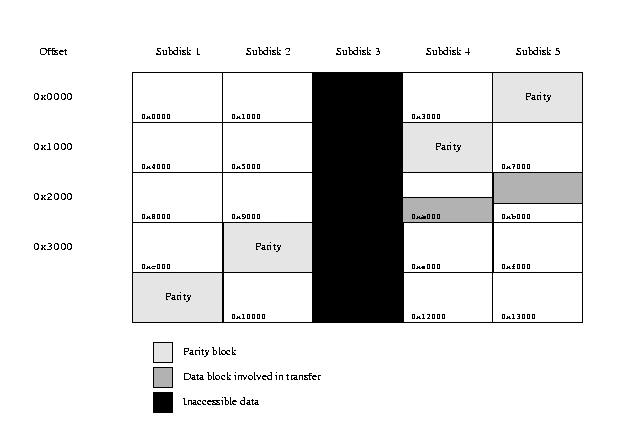
RAID-5 transfer with inaccessible parity block
This configuration poses no problems on reading, since all the data is
accessible. On writing, however, it is not possible to write the parity block.
It is not possible to recover from this problem at the time of the write, so the
write operation simplifies to writing only the data blocks. The parity block
will be recreated when the subdisk is brought up again.
Driver structure
Vinum can issue multiple disk transfers for a single I/O request:
-
As the result of striping or concatenation, the data for a single request may
map to more than one drive. In this case, Vinum builds a request structure
which issues all necessary I/O requests at one time. This behaviour has had the
unexpected effect of highlighting problems with dubious SCSI hardware by
imposing heavy activity on the bus.
-
As seen above, many RAID-5 operations require a second set of I/O transfers
after the initial transfers have completed.
-
In case of an I/O failure on a resilient volume, Vinum must reschedule the I/O
to a different plex.
The second set of RAID-5 operations and I/O recovery do not match well with the
design of UNIX device drivers: typically, the ``top half''
of a UNIX device driver issues I/O commands and returns to the caller. The
caller may choose to wait for completion, but one of the most frequent uses of a
block device is where the virtual memory subsystem issues writes and does not
wait for completion.
UNIX device drivers run in two separate environments. The ``top half'' runs in
the process context, while the ``bottom half'' runs in the interrupt context.
There are severe restrictions on the functions that the bottom half of the
driver can perform.
This poses a problem: who issues the second set of requests? The following
possibilities, listed in order of increasing desirability, exist:
-
The top half can wait for completion of the first set of requests and then
launch the second set before returning to the caller. This approach can
seriously impact system performance and possibly cause deadlocks.
-
In a threaded kernel, the strategy routine can create a thread which waits for
completion of the first set of requests and starts the second set without
impacting the main thread of the process. At the moment this approach is not
possible, since FreeBSD currently does not provide kernel thread support. It
also appears likely that it could cause a number of problems in the areas of
thread synchronization and performance.
-
Ownership of the requests can be ``given'' to another process, which will be
awakened when they complete. This process can then issue the second set of
requests. This approach is feasible, and it is used by some subsystems, notably
NFS. It does not pose the same severe performance penalty of the previous
possibility, but it does require that another process be scheduled twice for
every I/O.
-
The second set of requests can be launched from the ``bottom half'' of the
driver. This is potentially dangerous: the interrupt routine must call the
start routine. While this is not expressly prohibited, the
start routine is normally used by the top half of a driver, and may call
functions which are prohibited in the bottom half.
Initially, Vinum used the fourth solution. This worked for most drivers, but
some drivers required functions only available in the ``top half'', such as
malloc for ISA bounce buffers. Current FreeBSD drivers no longer call
these functions, but it is possible that the situation will arise again.
On the other hand, this method does not allow I/O recovery. Vinum now uses a
dæmon process for I/O recovery and a couple of other housekeeping activities,
such as saving the configuration database. The additional scheduling overhead
for these activities is negligible, but it is the reason that the RAID-5 second
stage does not use the dæmon.
Availability
Vinum is available under a Berkeley-style copyright as part of the FreeBSD
distribution. It is also available from LEMIS. The RAID-5
functionality was developed for Cybernet,
Inc., and is included in their NetMAX Internet connection package.
In August 1999, Cybernet released this code under the Berkeley license, and it
was part of the FreeBSD 3.3 release.
Future directions
The current version of Vinum implements the core functionality. A number of
additional features are under consideration:
References
[CMD] CMD Technology, Inc June 1993, The Need For RAID, An
Introduction.
[Cybernet] The NetMAX
Station. The first product using the Vinum Volume Manager.
[FreeBSD] FreeBSD home page.
[IBM] AIX
Version 4.3 System Management Guide: Operating System and Devices, Logical
Volume Storage Overview
[Linux] Logical Volume Manager for
Linux,
[McKusick] Marshall Kirk McKusick, Keith Bostic, Michael J. Karels, John
S. Quarterman. The Design and Implementation of the 4.4BSD Operating
System, Addison Wesley, 1996.
[OpenSource] The Open Source Page.
[rawio]A raw disk I/O
benchmark.
[SCO] SCO Virtual
Disk Manager. This document gives a good overview of a technology similar
to Vinum.
[Solstice] DiskSuite
[Veritas] The VERITAS
volume manager
[Wong] Brian Wong, RAID:
What does it mean to me?, SunWorld Online, September 1995.


















